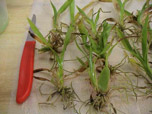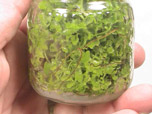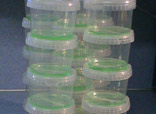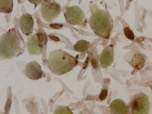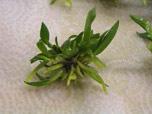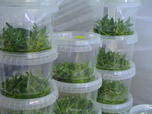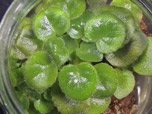Testimonials
Julie Richards , Research Officer, Crop Biology Resource Centre, South African Sugarcane Research Institute writes:
Use of PPM in the SASRI Tissue Culture Laboratory
The tissue culture laboratory at the South African Sugarcane Research Institute (SASRI) at Mount Edgecombe, KwaZulu Natal, South Africa uses tissue culture for both the transformation and micropropagation of sugarcane. While microbial contamination levels are generally low enough to be acceptable, we have experienced instances where contamination levels rise and become problematic. Such instances are generally attributed to changing environmental conditions.
We initially started using PPM primarily as a precautionary measure during the initiation of sugarcane somatic embryo cultures. Explant material consists of immature leaf roll tissue from the apical region of the sugarcane plant. The outermost leaves are aseptically removed, and the young, innermost, tightly furled leaves are sliced into transverse sections approximately 1.5mm thick. The explants were initially sliced “dry” (i.e. on a sterile glass plate), however this method resulted in the relatively high production of phenolics, which often inhibited the explant growth. We therefore modified our approach to slicing the explants in liquid medium (the same MS-based formulation as the semi-solid embryo-initiation medium, minus the agar). A small volume of liquid medium is poured into a petri dish, the leaf roll is placed in the liquid medium and the explants sliced off. These are then transferred to the semi-solid embryo-initiation medium. This approach resulted in the significant reduction in phenolic production. However, a drawback to slicing the explants in liquid medium is that if one or two explants from a leaf roll are contaminated, the risk exists for that contamination to spread to the remaining explants. To overcome this, the liquid medium is supplemented with 0.2% PPM, and our microbial contamination levels are subsequently very low.
A recent problem we have experienced involves the transformation of sugarcane tissue, more specifically, the pre-emergent floral initials. Since flowering of sugarcane in the field under South African environmental conditions can be unpredictable, sugarcane plants in this particular instance were induced to flower by growing them in specific conditions where longer day-lengths and elevated temperatures were controlled in a growth room. During the week of culture prior to transformation, no contamination of the pre-emergent inflorescent tissue, which was placed on semi-solid embryo-initiation medium, was observed. During the week following the transformation, however, a specific bacterial contaminant frequently emerged from within the tissue. This contaminant was not observed when pre-emergent inflorescent material from field-grown sugarcane was transformed. It was hypothesized that the elevated temperature and humidity inside the growth room encouraged the growth of the observed contaminant in the region of the inflorescence tissue. This contaminant remained latent during the initial culture period. However, the stressful conditions of transformation (including biolistic gene delivery and a short period of exposing the explants to culture medium with high osmotic pressure) caused the manifestation of the contaminant. A high proportion of potentially transformed explants were lost due to this specific contaminant. This problem was effectively brought under control with the use of PPM. According to our transformation protocol, four hours prior to transformation explants are placed on a high osmotic pressure medium. PPM (at a concentration of 25%) was either pipetted directly onto the explants on the osmotic medium, or the PPM was incorporated into the osmotic medium at a concentration of 1% (the latter method is easier when large numbers of transformations are to be carried out). Following biolistic transformation and a further four hours on the osmotic medium the explants are transferred to selection medium, which was supplemented with 1% PPM. Following this regime, the bacterial contamination of the transformed tissue was eliminated.
The third case where we use PPM in our laboratory is with the micropropagation of sugarcane plants in liquid medium. The system used for this involves a temporary immersion routine using commercially available RITA® vessels. With this system, 30 explants obtained from one sugarcane leaf roll are pooled into one vessel. A major disadvantage of this technique is that if one or two of those explants are contaminated, the liquid medium in the vessel rapidly becomes contaminated and all 30 explants are lost. A preliminary culture period of one week on semi-solid medium can assist with the detection of contamination, but often the contamination is latent or slow growing and only manifests later in the culturing regime. To reduce contamination levels in the liquid culture vessels, between 0.75 and 1% PPM is added to the liquid growth medium. Preliminary studies showed that concentrations of PPM greater than 25% are phytotoxic to sugarcane tissue, however concentrations of about 1% are quite adequate to satisfactorily reduce microbial contamination in the RITA® liquid culture system.
The use of PPM in the above instances has proven very successful in controlling the microbial contamination levels in our tissue culture programme. Furthermore, with the development of new techniques and protocols, it is reasonable to assume that additional problems with contamination are likely to be encountered. PPM will therefore continue to be stocked as a standard consumable item in our laboratory.

